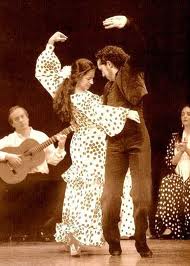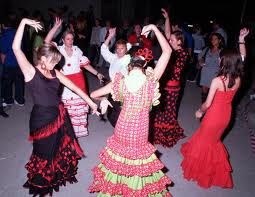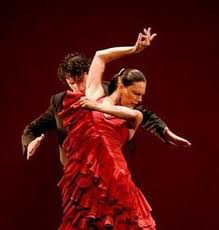Sevillanas

Sevillanas are a song and dance form which is typical of the Spanish town of Seville, but they are sung and danced across the Andalusian region. Today, it is possible to find schools teaching Sevillanas all over Spain and the world.
Sevillanas
This Spanish dance has its origins in the time of the 'Reyes Católicos' (Catholic Monarchs), around the 15th Century. It is also believed that the Sevillanas were developed from the Castilian version, Seguidillas. Over the centuries, and especially in the 18th Century, the Sevillanas mixed with other Spanish dance forms, like Flamenco, to give the large variety of dances you can find today.
Despite their long history, the word 'Sevillanas' meaning a type of Spanish dance only made it into the Spanish language dictionary in 1884. Before this time, the Real Academia Española (Royal Spanish Academy) did not officially recognise the word with this meaning.
The music that accompanies the Sevillanas dancers tends to be rather simple. However, the song that accompanies this Spanish dance has a wide variety of lyrics and themes. The song was, up until the second half of the 20th Century, a song sung by the people of the town for the people of the town. They often described daily life in the town, however they also included criticisms, warnings and funny stories that the singers had experienced. In fact, over the centuries, an infinite number of song themes were developed, including songs about religion, regions, love, biblical stories and festivals.

In the 1950s, the first music records of Sevillanas began to be released. There were many important artists at this time who helped increase the popularity of this Spanish dance such as Manuel Pareja Obregón, an important composer, and María del Monte, a successful singer of Sevillanas.
Los Hermanos Reyes (The Reyes Brothers), from Castilleja de la Cuesta, a province of Seville, were revolutionary in this field as they changed the entire melody all the time, yet managed to be original every time, never repeating a Sevillana.
Sevillanas are the most popular and well-known folk dance from Spain. It is the regional dance which is performed the most across the country and the world, with many professional dancers and schools in Spain and abroad.
Sevillanas are divided into four or seven parts. These parts are then divided into three coplas (verses), and each copla is then split into six parts. The last copla always ends with the music. The dance itself tends to be danced in pairs, yet can be danced solo in experimental versions of the dance. There are four movements in the dance: paseíllos, pasadas, careos and remate.

The dancers of Sevillanas are normally accompanied by guitars. The key in which the guitar plays depends entirely on that of the singer. Sometimes clapping or castanets are used to give more feeling and occasionally they use a tambourine. The music is in 3/4 metre but some believe that it sounds better in 6/8 metre.
Sevillanas tend to be danced and sung at many festivals which are celebrated across the Andalusian region, especially on the Feria de Abril de Sevilla, El Rocío and Andalusian national days.
The Sevillanas are similar in style to that of Flamenco. Due to Flamenco's fame, people who travel to Spain often mistake people dancing Sevillanas as people dancing the Flamenco. However, Flamenco experts and purists tend to exclude Sevillanas as an impure dance form.
Yet, as a Spanish dance that is danced at festivals and parties, the steps tend to be much more standardised with little variation. That means that it is a great dance to start with when beginning to learn Flamenco, as the steps are similar yet much easier to learn.
